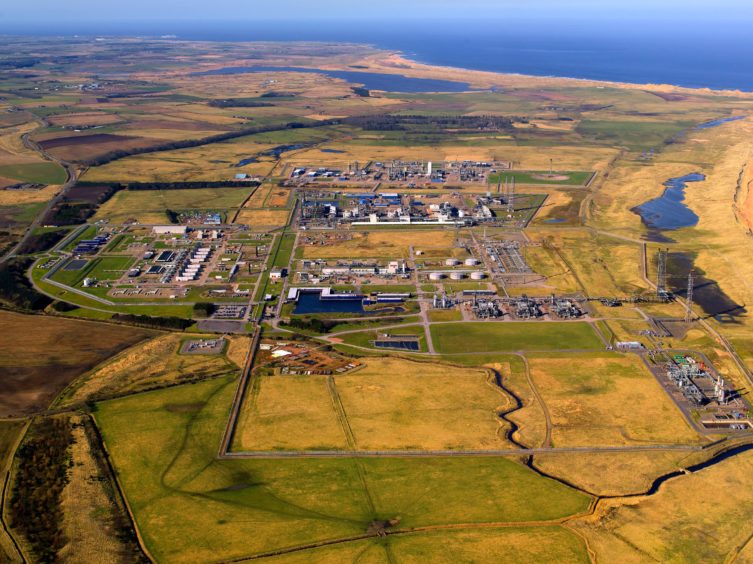
“I’m really not that interested in creating a glossy report. What I want is solid concept engineering; here is a tool that allows industrial sites to look at the options and start this journey to decarbonisation.”
Mike Smith, chief executive of North East Carbon Capture Utilisation and Storage (Neccus) Scotland, is determined to ensure that the group’s industrial net-zero roadmap doesn’t become just another set of recommendations.
“Working out how it will fit in this energy system model, that for me is the practical piece of all of this and that’s really what we want to focus on more than anything else,” he explained.
And it’s fair to say the group has its work cut out.
Neccus, which is a coalition of industry, academia and public bodies, is aiming to plot a course for decarbonising scores of sites along Scotland’s east coast that account for around 80% of the country’s industrial emissions.
Last month, it was announced the group had secured £1.23 million from the UK Government to help develop the roadmap, following an initial design project that was submitted to Westminster in 2020.
“It’s not an easy thing to do”, Smith said, adding that the project is likely to run for the next two years.
He said: “We’re talking about 30 sites across the east coast of Scotland, running from Aberdeenshire in the north to East Lothian in the south.
“We’re talking about multiple sectors of industry including cement, paper, chemicals and oil and gas.
“The hope is if we can find solutions that work for 80% of the emissions in Scotland then they’ll work for the other 20% as well.”
Indeed, Neccus is keen that its roadmap can act as a basis for decarbonisation of heavy industry across the UK, as well as Scotland.
Key to that is collaboration and the group has held frequent discussions with industrial clusters to establish the challenges and opportunities facing each area.
Smith said: “If we were to set out the necessary skills to decarbonise the north-east in isolation, that wouldn’t be nearly as effective as trying to do it across all of the clusters and ultimately collaborating with other groups that are looking at doing the same thing.
“Some regions have fantastic plans but don’t have a logical place to store their CO2. But in Scotland, hydrocarbon exploration means that we’re in a fantastic place to be that long-term storage site – that’s very well understood.
“There’s also some fantastic work going on in Holyrood and Westminster to develop the policy and regulations that are required to allow this to happen.”
When it comes to collaboration, both domestically and overseas, Neccus is in the fortunate position of having backing from some of the world’s leading industrial firms.
Oil and gas giants Shell and Chrysaor are involved in the project, as well as Cairn Energy, Grangemouth refinery owner Petroineos and gas distribution firm SGN.
In total, the project has 11 partners that will assist the development of the roadmap financially, as well by lending expert assistance.
Smith said: “While Neccus is the lead, we’ve got a group of fantastic partners that are working with us – we’re not delivering this alone.
“I think this also helps the supply chain with its own energy transition, which is something that’s going to happen in parallel with the roadmap.”
A criticism that is often levelled at roadmaps and blueprints is a perceived lack of measurable benefits.
In an effort to set this project apart from the rest, Smith says they’re looking to create “tools that can have a life beyond the project”.
To ensure the roadmap is as practical as possible, stakeholders and being encouraged to engage with it from the start.
“The results will only be as good as the inputs that we get”, Smith explained. “We need engagement, both with shareholders and across the sites.
“There are roughly 30 areas we’re examining and the more they’re willing to share their thoughts, their ideas, their issues, the more we can address them.
“We’re not going to be passive about this. We’ve been very proactive about going out and talking to those organisations. We had an initial phase last summer where we had some extensive engagements with about 100 key stakeholders across Scotland.
“A lot of the first six months of this project is about gathering that evidence base and information so that we can then build it into things like an energy systems model that will set out how all this works.”
A key pillar of Neccus’s efforts to decarbonise Scotland’s industry will be, as the group’s title suggests, carbon capture and storage (CCS).
However, Smith admits that there’s still work that needs to be done in order to convince the public of the technology’s importance in reducing emissions.
A recent report, commissioned by climate change groups Friends of the Earth Scotland and Global Witness, claimed CCS won’t be able to match the levels of CO2 abatement required in the next decade.
On scepticism about the technology, Smith said: “I think sometimes the conversations around CCS have been overly simplified.
“Some people think it’s just about exploiting more oil and gas and enhancing production. Historically, perhaps that has been the case, but no one in Europe is using it for that going forward.
“A lot of the technologies that were first used in offshore wind came from the oil and gas sector. Does that mean that those were wrong? It’s about what you do with them now that’s important.
“The other argument is that you can give a cement plant an infinite amount of renewable electricity but the processes involved will still create CO2. That needs to go somewhere because in 2045, when Scotland’s net zero, we’ll still need houses, hospitals and bridges.”
The Acorn project at the St Fergus gas terminal in Aberdeenshire is exploring using traditional oil and gas infrastructure to inject carbon into depleted gas reservoirs under the North Sea.
Smith is keen to highlight that, beyond Acorn, there’s widespread decarbonisation work ongoing that means the north-east is well placed to become a “centre of excellence”.
He said: “The east coast of Scotland is going to see massive growth in things like offshore wind that will provide the feed stock to green hydrogen. The Dolphyn project, which is being developed off the coast of Aberdeenshire, will be key to that.
“The transport and storage of CO2 long-term is another area where the north-east can excel. There are some world-class deep-water ports along our coastline which, due to the oil and gas industry, are used to handling large bulk products.
“Those can be used to bring CO2 in from other parts of the country and potentially from other parts of Europe. It will also allow for the export of hydrogen.
“There are a number of decarbonisation projects ongoing and these all need to be encouraged because the drive to net zero is probably one of the most fundamental changes to the economy that we’re ever going to see.”

 © Supplied by Neccus
© Supplied by Neccus